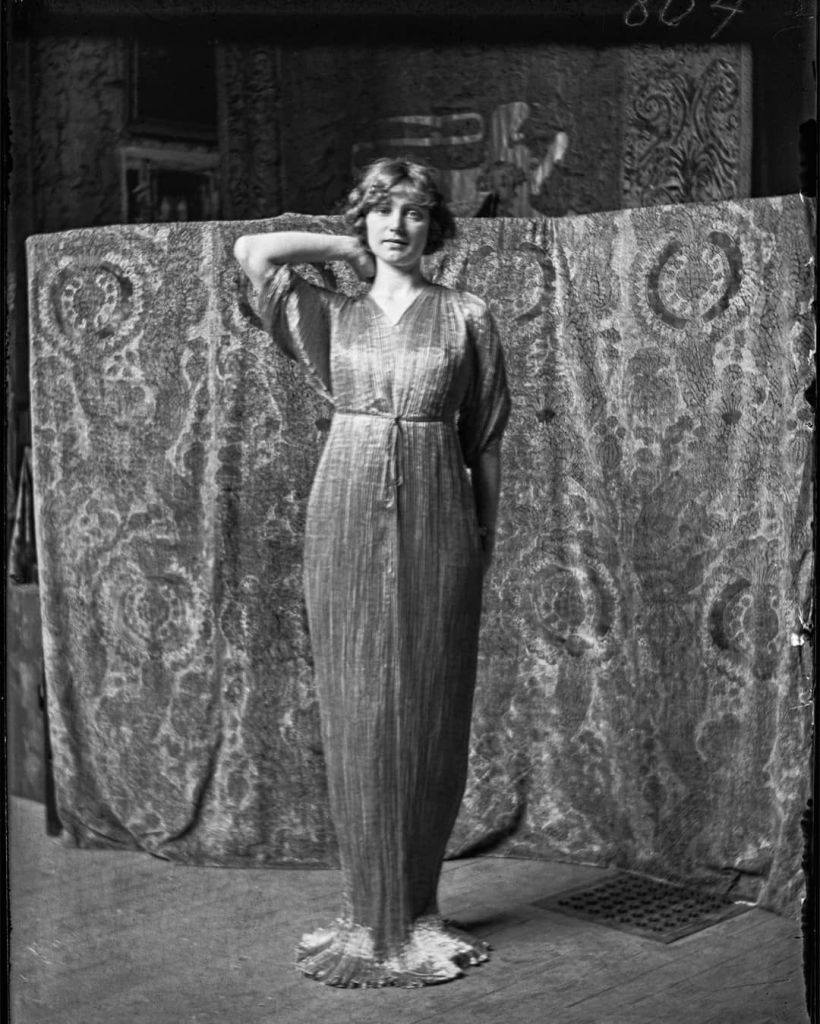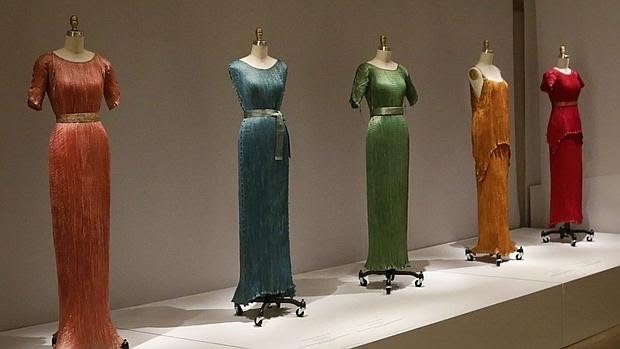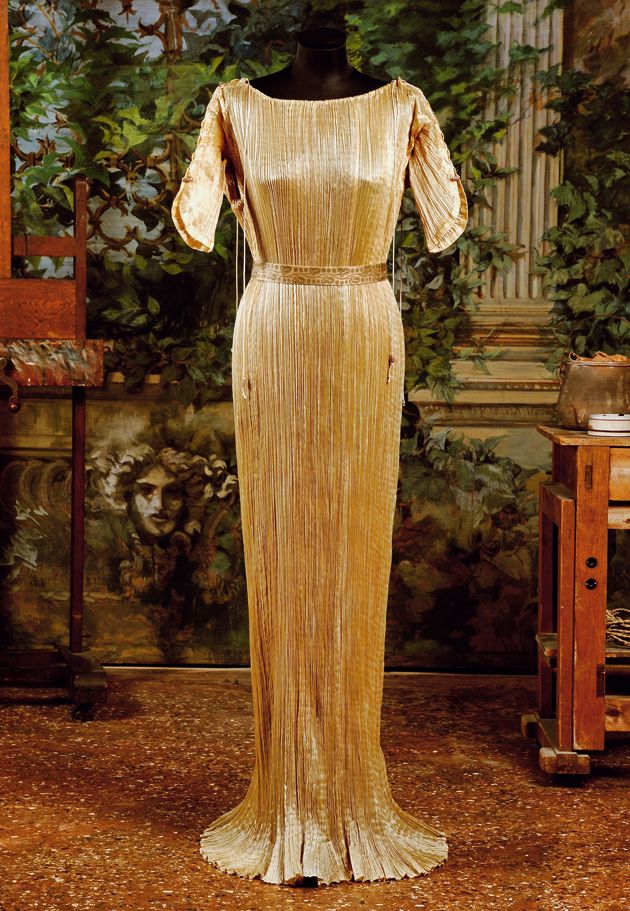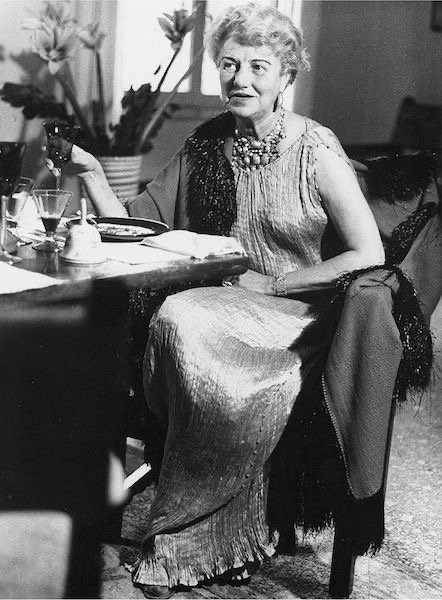EXOTIC princesses, chatty socialites, entitled heiresses and liberated, independent women were all seduced by the elegant, sumptuous richness of the ‘Delphos‘ gown. A cascade of silky softness, exquisite colour and delicate folds. A dress that transformed the wearer into a Greek goddess, a classical beauty, for whom a thousand ships might be launched at any moment. A dress of extreme sensuality, that emphasised the female form, whilst concealing it modestly in the most luxurious of fabrics. A divine blend of style, mystery and sophistication.
ALCHEMY – Mariano Fortuny and his wife Henriette Negrin designed and created the ‘Delphos’ dress in their workshop in Venice in the early 1900s. Spanish and French respectively, the couple were inspired by the aquatic city’s exceptional architecture and the richness of fabrics imported from the east. Fortuny was a talented painter, theatre designer and inventor. Negrin was an accomplished textile designer. As the new century dawned, Paris was awash with enthusiasm for ‘Orientalism’ and exotic ideas relating to the East. French archaeologists working at Delphi, north of Athens, had recently discovered a bronze statue, dating from about 500 years before Christ. The figure was named ‘The Charioteer’ and was clad in elegant, pleated robes. The ‘Delphos’ dress was inspired by the draped costume of this and other Greek statuary. Not only did Fortuny and Negrin design a dress that perfectly captured the mood of turn-of-the-century Paris, they also invented and patented a ‘pleating technique’ that gave the Delphos gown its unique fluidity and elegance.




A DRESS like the ‘Delphos’ couldn’t have appeared at a better time. Fabulous, high quality silk, brilliant colours and unique, contour-enhancing pleating was revolutionary to the bodice and corset-wearing generation of La Belle Epoque. The gown was soft and unstructured and designed to enhance the wearer’s natural curves. Wearing a ‘Delphos‘ gown transformed a lady into a Greek goddess….as if by magic! Women loved the sensual style of this exquisite garment. A new look for the new century. As for Mariano Fortuny and Henriette Negrin, it was the ‘Delphos‘ gown that made them famous. Whilst the gowns were made in Venice they were mostly sold from a boutique in Paris. After all Paris was the capital of fashion even then and Mariano Fortuny wasn’t going to miss such a wonderful opportunity.



THE DELPHOS GOWN – It wasn’t long before the ‘Delphos’ gown was being sold not just in Venice and Paris but in America as well. Elsie McNeill Lee, a fashion designer from New York became a distributor of Fortuny garments from her store on Madison Avenue and was Fortuny’s sole importer into the US. This was the age of the grand ocean liners and it’s easy to imagine the ladies in First Class appearing for dinner wearing the most exquisite and elegant of Fortuny gowns.I like to imagine Zelda Fitzgerald clad in an emerald green Delphos gown as she strolled on the timber deck of a Transatlantic liner.



MARIANO FORTUNY’S CLIENT LIST was quite something. From the early days customers included Eleonora Duse, the famous Italian character actor and Isadora Duncan, performer, dancer and socialite. In fact one of Eleonora Duse’s gowns is now in the V & A Museum in London. La Duse was THE diva of her day, she performed in Italy and the United States and was famous in Italy not just for her acting but also for her romance with Gabriele d’Annunzio the poet. Eleonora Duse was the first woman to appear on the cover of TIME Magazine in 1923. She was the perfect model for Fortuny’s pleated silk dress. Other famous clients included Mrs Conde Nast, Peggy Guggenheim and later Lauren Bacall. The ‘Delphos’ gown developed a life of it’s own, as Lady Bonham Carter (British aristocrat) commented, ‘I think everyone I knew had a Fortuny dress’. The interesting thing about the ‘Delphos’ gown was that it became a symbol not just of style and elegance but also of female liberation and emancipation. These gowns are now considered important pieces of early 20th century fashion history and are regarded as art objects in their own right.





RECENT DEVELOPMENTS – Since the 1970s the popularity of fashion history has grown enormously. In 2016 The Metropolitan Museum in New York hosted a Fortuny show and the photograph above shows some of the gowns on display. Then in the last few years the ‘Delphos’ gown has featured in Downton Abbey, firstly the TV series and more recently the film, worn by main character Lard Mary Crawley. This beautiful contemporary example of the dress shows clearly the pearls or glass beads that were sown onto the seams of the dress to weigh it down slightly and improve the way the gown falls. Originally these beads would have been made of Murano glass, created in Venice, just like the dress. The unique pleating technique that Negrin and Fortuny had patented in Paris, more than one hundred years earlier, gives the dress a unique and elegant form.

I wonder if Mariano Fortuny and Henriette Negrin realised they were creating a garment of great beauty, that would develop a life and persona of its own over the years. Even after the death of Mariano, when Henriette decided to cease production of the gown, it refused to die. The Fortuny distributor in America, Elsie McNeill Lee ended up taking over the business, moving to Venice and marrying an Italian Count. This really is the stuff of legend. In the late 1980s she then sold the business to a friend and confidante, whose family continue to run the business to this day. Visitors to Venice can still see the Fortuny Factory on the Giudecca, next door to the Molino Stucky. It’s not open to the public so only the fortunate few can hope to take a look inside. Wouldn’t it be wonderful to step inside those hallowed walls and listen to what the looms have to say!

Notes:
- DEFINITION -The ‘Delphos’ gown was a finely pleated silk dress first created in about 1907 by Henriette Negrin (1877-1965) and her husband Mariano Fortuny (1871-1949). It was a luxurious, loose fitting tunic, made until about 1950.
- Fortuny and Negrin applied to patent their silk pleating technique in Paris in 1909. This unique ‘pleating technique’ gave the ‘Delphos’ its unique structure, look and fluidity.
- The Palais Galliera, Fashion Museum in Paris has a superb example of a Delphos Gown in it’s collection. Palais Galliera, Paris – Fortuny
- Here’s the extract of Fortuny’s application to patent his ‘silk pleating’ technique in 1909, ”Le 4 novembre 1909, il dépose un brevet à Paris sur ce vêtement, le brevet d’invention n°408.629, intitulé «Genre de vêtement pour femmes». Il y précise notamment qu’il s’agit d’une robe « consistant essentiellement en un fourreau ouvert à ses deux extrémités dont les bords sont rapprochés à la partie supérieure de manière une ouverture centrale d’encolure, deux ouvertures latérales pour les bras et deux ouvertures à bords rapprochés par un laçage s’étendant le long des bras avec des coulisses obliques..”
- Extract from: Isabelle Renard, « Mariano Fortuny », dans Fashion Mix. Mode d’ici, créateurs d’ailleurs. Palais Galliera et Editions Flammarion, 2014, p 66-70.

Delphos Dress – Palais Galliera, Paris designed by Mariano Fortuny and his wife Henriette Negrin. They patented the folded, pleated, silk technique in 1909.

- The Fortuny Museum, Venice is housed in the Palazzo Pesaro Orfei, a magnificent Venetian Gothic palace which was the home, studio and workshop of Mariano Fortuny and his French wife Henriette Negrin from 1902 until her death in 1965. It is well worth a visit when you are next in Venice. The Palazzo Fortuny, Venezia
- I’ve written a couple of articles about fashion and clothing exhibitions.
- The idea that fashion can precipitate social change is intriguing: London – the glamour of the 20s
- And lastly: It’s a small world – putting on the glitz
- If you’d like to experience a truly, tailor-made trip to Venice then check out our sister company: www.grand-tourist.com for exceptional tailor-made travel

- For other articles on Greece: A little piece of Greece in Venice (about the Greek community in Venice)
- Greece – Oracle of Delphi
- Santorini to Thessalonika – A Tour of Greece from vine to wine
- Written and published by Janet Simmonds #grand tourist #educatedtraveller
- www.greyhoundtrainers.com
A NOTE ON THE METROPOLITAN MUSEUM, NEW YORK (and it’s involvement with fashion history):
The Costume Institute (New York) began as the Museum of Costume Art, formed in 1937 and led by Neighborhood Playhouse founder Irene Lewisohn. In 1946, with the financial support of the fashion industry, the Museum of Costume Art merged with The Metropolitan Museum of Art as The Costume Institute, and in 1959 became a curatorial department. The legendary fashion arbiter Diana Vreeland, who served as special consultant from 1972 until her death in 1989, created a memorable suite of exhibitions, including The World of Balenciaga (1973), The Glory of Russian Costume (1976), and Vanity Fair (1977), galvanizing audiences and setting the standard for costume exhibitions globally.
In 1989, Richard Martin took the helm, with the support of Harold Koda, and began a rotating cycle of thematic exhibitions including Infra-Apparel, Waist Not, The Four Seasons, and Cubism and Fashion. Martin’s tenure culminated in Rock Style, the last exhibition before his death in 1999. Mr. Koda rejoined The Met in 2000 as curator in charge, hiring Andrew Bolton in 2002. Upon Mr. Koda’s retirement in January 2016, Mr. Bolton became curator in charge, and in March 2018, upon the endowment of the postion, he was named the Wendy Yu Curator in Charge. Extract from: www.metmuseum.org
- 12-11-2019
- 01-08-2022
- 01-12-2022

It is not true that the Metropolitan Museum of Art did not have a fashion collection before 2003. It’s such a bizarre statement I wonder where this information would even come from. The Met – as is explored in many places – has had a fashion, costume, and textiles collection throughout the 20th century. When Diana Vreeland left magazine editing she directed their splendid fashion exhibitions from the late 1970s.
LikeLiked by 1 person
I am on a very deep dive research on anything historical and vintage. And the Delphos Gown’s creation and their creators were also inspired by history, and now we are inspired by the history they’ve made! What a great blog post! It certainly captured a feeling of being a part of fashion and art history.
LikeLiked by 1 person
Fascinating stuff, Janet, even if my couturial interest and knowledge doesn’t match my musical ones!! Is there ANYTHING on which you are not an expert?!
One impressed reader.
LikeLiked by 1 person
I love reading your writings about fashion, Janet–the history behind the designs is fascinating!
LikeLiked by 1 person
Thank you MLP – I love discovering the social history behind the fabrics….
LikeLiked by 1 person